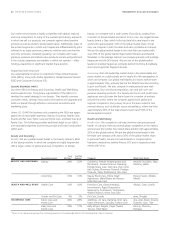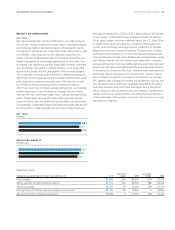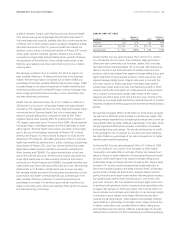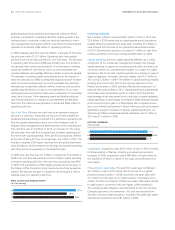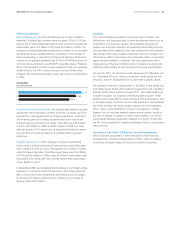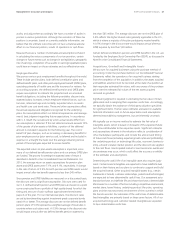Proctor and Gamble 2010 Annual Report Download - page 40
Download and view the complete annual report
Please find page 40 of the 2010 Proctor and Gamble annual report below. You can navigate through the pages in the report by either clicking on the pages listed below, or by using the keyword search tool below to find specific information within the annual report.38 The Procter & Gamble Company Management’s Discussion and Analysis
Venezuela Currency Impacts
On January1, 2010, Venezuela was designated as a highly inflationary
economy under U.S. GAAP. As a result, the U.S. dollar became the
functional currency for our subsidiaries in Venezuela. Beginning in our
third fiscal quarter, currency remeasurement adjustments for non-dollar
denominated monetary assets and liabilities held by these subsidiaries
and other transactional foreign exchange gains and losses are being
reflected in earnings and will continue to be reflected in earnings on
an ongoing basis. Through December31, 2009 (prior to being desig-
nated as highly inflationary), translation adjustments were reflected in
Shareholders’ Equity as part of accumulated other comprehensive
income.
On January8, 2010, the Venezuelan government announced its
intention to devalue the Bolivar Fuerte relative to the U.S. dollar. The
official exchange rate for imported goods classified as essential, such
as food, medicine and capital investments, changed from 2.15 to 2.6,
while payments for other non-essential goods moved to an exchange
rate of 4.3. Many of our imported products fall into the essential
classification and qualify for the 2.6 rate. However, our overall results
in Venezuela are reflected in our Consolidated Financial Statements at
the 4.3 rate expected to be applicable to dividend repatriations.
The remeasurement of our local balance sheets in the third fiscal
quarter to reflect the impact of the devaluation did not materially
impact our results. This was due to the relatively small non-dollar
denominated net monetary asset position in Venezuela. There will be
an ongoing impact related to measuring our income statement at the
new exchange rates. Moving from the 2.15 rate to 4.3 will reduce
future total Company reported sales by less than 2% on a going basis.
For the year ended June30, 2010, the impact was about 1%. This
does not impact our organic sales growth rate, which excludes the
impact of foreign currency changes. Versus our original business plans,
the exchange rate change reduced our reported earnings per share by
approximately $0.08 in 2010, with a similar impact expected in 2011.
This impact includes the devaluation impact on Venezuela-related
foreign currency exchange costs.
In our fourth fiscal quarter, the Venezuelan government introduced
additional exchange controls over securities transactions in the parallel
market. They established the Central Bank of Venezuela as the only
legal intermediary through which parallel market transactions can
be executed and established government control over the parallel
exchange rate (which was approximately 5.3 at June30, 2010). At
the same time, they significantly reduced the notional amount of
transactions that run through this parallel market mechanism, which
has eliminated our ability to access the parallel market to pay for
imported goods and/or manage our local monetary asset balances.
As of June30, 2010, we had net monetary assets denominated in
local currency of approximately $350million. Approximately $170
million of this balance has been remeasured using the parallel rate,
because we plan to use that amount of the net assets (largely cash)
to satisfy U.S. dollar denominated liabilities that do not qualify for
official rate dollars. The availability of the parallel market to settle these
transactions is uncertain. The remaining net monetary asset balances
are currently reflected within our Consolidated Financial Statements
at the 4.3 official exchange rate. Depending on the future availability
of U.S. dollars at the official rate, our local U.S. dollar needs and our
overall repatriation plans, we have exposure for the differential
between the official and parallel exchange rates on this portion of
our local monetary assets.
Over time, we will attempt to restore the sales and profit levels
achieved prior to the devaluation. However, our ability to do so will be
impacted by several factors, including the Company’s ability to mitigate
the effect of the devaluation, further actions of the Venezuelan
government, economic conditions in Venezuela such as inflation and
consumer spending, the availability of raw materials, utilities and energy
and the future state of exchange controls in Venezuela including the
availability of U.S. dollars at the official foreign exchange rate.
SEGMENT RESULTS
Results for the segments reflect information on the same basis we
use for internal management reporting and performance evaluation.
Within the Beauty and Grooming GBU, we provide data for the
Beauty and the Grooming reportable segments. In the Health and
Well-Being GBU, we provide data for the Health Care and the Snacks
and Pet Care reportable segments. In the Household Care GBU, we
provide data for the Fabric Care and Home Care and the Baby Care
and Family Care reportable segments. All references to net earnings
throughout the discussion of segment results refer to net earnings
from continuing operations.
The results of these reportable business segments do not include
certain non-business unit specific costs such as interest expense,
investing activities and certain restructuring costs. These costs are
reported in our Corporate segment and are included as part of our
Corporate segment discussion. Additionally, as described in Note11
to the Consolidated Financial Statements, we have investments in
certain companies over which we exert significant influence, but
do not control the financial and operating decisions and, therefore, do
not consolidate these companies for U.S. GAAP purposes (“unconsoli-
dated entities”). Given that certain of these investments are managed
as integral parts of the Company’s business units, they are accounted
for as if they were consolidated subsidiaries for management and
segment reporting purposes. This means pretax earnings in the business
units include 100% of each pretax income statement component.
In determining after-tax earnings in the business units, we eliminate
the share of earnings applicable to other ownership interests, in a
manner similar to noncontrolling interest, and apply the statutory tax
rates. Eliminations to adjust each line item to U.S. GAAP are included
in our Corporate segment.






